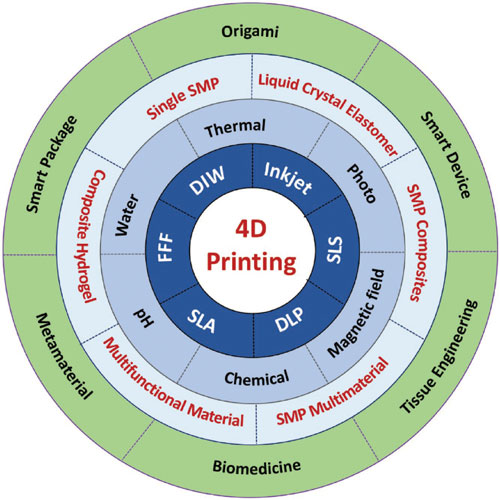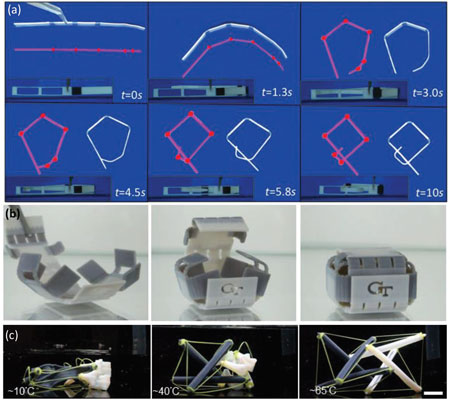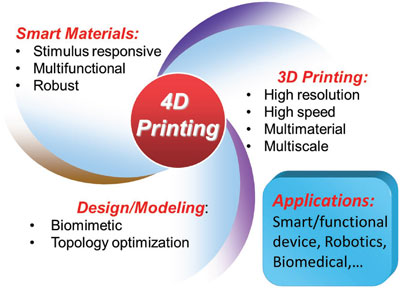| Jan 31, 2019 | |
Material systems used in 4D printing |
|
| (Nanowerk Spotlight) Compared to creating static objects with 3D printing, 4D printing systems add time as the fourth dimension to 3D printing: 4D printing allows a 3D printed structure to change its configuration or function with time in response to external stimuli such as temperature, light, water, pH, etc. | |
| 4D printing, still in its infancy (the term was first introduced in 2013 in a TED talk), has become an exciting branch of additive manufacturing and attracts enormous interest from academia and industry of different disciplines. | |
| The basic idea is to manipulate materials at nano and micro levels in order to produce, via 3D printing, materials that can modify their structures over time at the macro level. | |
| As shown below, based on 4D printing, 3D printed objects from nano- to macroscale can be fabricated as smart devices, metamaterials, and origami for various functional applications in prototype, aerospace, biomedicine, etc. | |
 |
|
| 4D printing, referred to as 3D printing plus time, enables shape or function evolution with time after printing using different materials under the internal stimuli, such as the self-folding of a 4D printed flat sheet into a box. The elements and the categories involved in 4D printing are shown. 1) 3D printing technology: FFF, DIW, DLP, SLS, inkjet, and SLA. 2) The stimulus for 4D printing: thermal, photo, water, pH, chemical, and magnetic field. 3) Material systems for 4D printing: single SMP, liquid crystal elastomer, composite hydrogel, SMP composites, SMP multimaterial, and other multifunctional material. 4) Applications for 4D printing: origami, smart device, smart package, metamaterial, tissue engineering, and biomedicine. (Reprinted with permission by Wiley-VCH Verlag) | |
| A recent article in Advanced Functional Materials ("Advances in 4D Printing: Materials and Applications") reviews the material systems used in 4D printing by emphasizing mechanisms and potential applications. | |
3D Printing of shape-shifting material by a single material |
|
| The simplest way to achieve 4D printing is 3D printing a single smart material. The most widely used single smart materials for shape shifting are shape memory polymers (SMPs) and liquid crystal elastomers (LCEs). | |
| SMPs are a group of polymers that can maintain a temporary shape and recover their initial shape in the presence of an external stimulus, such as heat or light. Side-chain or main-chain LCEs with liquid crystal molecules (or mesogens) can undergo a large contraction along the direction of the mesogens under external stimulus. | |
| Thus, 4D printing can be achieved by printing a single SMP or LCE with one-way actuation or two-way reversible actuation, respectively. | |
4D Printing by multimaterials and composites |
|
| The most widely used multimaterial systems for 4D printing include water- and thermal-responsive composite hydrogels, fiber-reinforced or bilayer SMP composites, multimaterial SMPs, and desolvation-induced multimaterials. In the latter, the volume shrinkage by desolvation of the residual unreacted component can been exploited to achieve shape changing. | |
| In a multimaterial structure, eigenstrains can be generated due to environmental stimuli; these eigenstrains are dependent on the relative positions and volume fractions of different materials and can drive the shape change of the structure. | |
 |
|
| 4D printing by SMP multimaterials. a) The comparison of experiments and the simulations of interlocking SMP component by 3D printing. b) 3D printed sheet folds into a box with a self-locking mechanism. c) Programmed deployment sequence of the two-layer tensegrity using two different SMPs for the struts (scale bars = 15 mm) (Reprinted with permission by Wiley-VCH Verlag) (click on image to enlarge) | |
4D Printing of multifunctional materials |
|
| Recently, the 4D printing concept has been expanded from its initial definition of shape shifting to including function or property shifting. This may open a new avenue to functional 4D printing such as 4D bioprinting and 3D printing of self-healing materials. | |
| First, printed functional objects, such as electronic devices, have been combined with the shape changing to achieve 4D printing of functional devices. | |
| Second, some functional properties – such as optics or conductivity properties – can also evolve with the process of shape changing for functional 4D printing. | |
| Third, the time-dependent functional properties – such as tissue maturation, degradability, self-healing, or color shifting for 3D printed constructs – can be broadly termed as 4D printing. | |
| In 4D bioprinting, the printed 3D biocompatible materials or living cellular structures evolve over time after printing. 4D bioprinting includes both the shape-shifting biomaterials and the maturation of engineered tissue constructs enabled by 3D printing. | |
| 4D bioprinting shows great potential for future biomedical applications, such as tissue engineering, drug delivery, and building functional organs that are suitable for transplantation and organ regeneration. | |
| Researchers have also investigated the 3D printing of self-healing materials that enable structural restoration and function recovery of materials after printing so as to enhance reliability and extend the lifetime of material systems. | |
Outlook |
|
| Similar to many other emerging technologies, there are still many challenges facing the embryonic 4D printing for practical applications. Many of these challenges are the target for intensive research but 4D printing is still very young and needs a significant amount of efforts for future development. | |
 |
|
| The further development of 4D printing for each element, including 3D printing technique, smart materials, and design/modeling as well as the most important potential applications. (Reprinted with permission by Wiley-VCH Verlag) | |
| Owing to the advantages of customized and personalized fabrication of bio-related materials, 4D bioprinting shows great potential in biomedical applications. For example, tailor-made suture, ischemic stroke devices, vascular repair device, and theragrippers can be achieved by 4D printing. | |
| Other potential applications in functional devices include sensing, energy harvesting, and storage. For example, 4D printing of actuator provides a good chance to access stimulus-responsive soft robots for energy storage and harvesting. | |
| As the authors conclude their review, "the advancement in new printing technologies, new smart materials, new structural design, and modeling tools/software will enable 4D printing to satisfy myriads of functional applications, including soft robotics, biomedicine, tissue engineering, electronics, defense, and security." | |
 By
Michael
Berger
– Michael is author of three books by the Royal Society of Chemistry:
Nano-Society: Pushing the Boundaries of Technology,
Nanotechnology: The Future is Tiny, and
Nanoengineering: The Skills and Tools Making Technology Invisible
Copyright ©
Nanowerk LLC
By
Michael
Berger
– Michael is author of three books by the Royal Society of Chemistry:
Nano-Society: Pushing the Boundaries of Technology,
Nanotechnology: The Future is Tiny, and
Nanoengineering: The Skills and Tools Making Technology Invisible
Copyright ©
Nanowerk LLC
|
|
|
Become a Spotlight guest author! Join our large and growing group of guest contributors. Have you just published a scientific paper or have other exciting developments to share with the nanotechnology community? Here is how to publish on nanowerk.com. |
|
